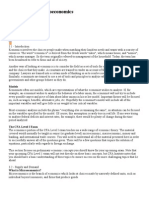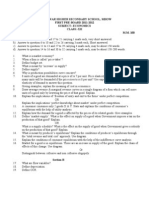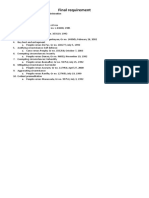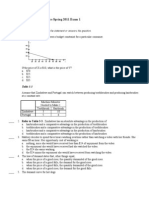Cagayan State University College of Business, Entrepreneurship & Accountancy Microeconomic Theory & Practice-Mid Terms Examination
Cagayan State University College of Business, Entrepreneurship & Accountancy Microeconomic Theory & Practice-Mid Terms Examination
Uploaded by
Hannah Alvarado BandolaCopyright:
Available Formats
Cagayan State University College of Business, Entrepreneurship & Accountancy Microeconomic Theory & Practice-Mid Terms Examination
Cagayan State University College of Business, Entrepreneurship & Accountancy Microeconomic Theory & Practice-Mid Terms Examination
Uploaded by
Hannah Alvarado BandolaOriginal Title
Copyright
Available Formats
Share this document
Did you find this document useful?
Is this content inappropriate?
Copyright:
Available Formats
Cagayan State University College of Business, Entrepreneurship & Accountancy Microeconomic Theory & Practice-Mid Terms Examination
Cagayan State University College of Business, Entrepreneurship & Accountancy Microeconomic Theory & Practice-Mid Terms Examination
Uploaded by
Hannah Alvarado BandolaCopyright:
Available Formats
Cagayan State University
College of Business, Entrepreneurship & Accountancy
Microeconomic Theory & Practice-Mid Terms Examination
Use a separate answer sheet which should contain your name, course, section and the answers
to this examination. Submit the answer sheet/s only to my email address. mstanjr@csu.edu.ph.
Test I. True or False
1. Land as a production factor pertains only to the soil where you can locate your business.
2. Production factors may be enhanced.
3. In economics, capital means money used for business.
4. Economics is a field of study that provides knowledge how to acquire all our needs and wants.
5. The entrepreneur may not necessarily be the manager of a business.
6. International economics studies the functioning of the national economy.
7. Economics falls under the field of natural sciences.
8. Payment for the entrepreneur is called salaries or wages.
9. Microeconomics is the smallest level of economic analysis.
10. A market necessitates a physical place of exchange.
11. Barter is the value of a good in terms of money.
12. Aggregate demand is a reflection of a consumer’s desire for a commodity.
13. Shortage represents the intersection between demand and supply.
14. A movement within the same demand or supply curve is mainly caused by changes in prices.
15. A shift of the demand curve to the left or right is normally caused by non-price factors.
16. Surplus represents the excess of supply over demand for a good.
17. In a market economy, the government sets the prices of commodities.
18. Shortage represents are area where demand is equivalent to supply.
19. Free goods can become economic goods.
20. Aggregate supply represents the amount of commodity a producer is willing to sell in the
market.
II. Graphing Exercise. Plot the following demand and supply schedule in a graph showing the
following:
a. Demand curve
b. Supply curve
c. Equilibrium point
d. Area of shortage
e. Area of surplus
Demand Schedule for Pork Daily
Price per Kg Quantity Demanded
(in PhP) (# kgs.)
150 550
180 310
210 210
240 170
270 90
III. Essay. Answer the following questions briefly but adequately.
1. Elaborate on the similarities and differences between economic theories and price theory. Cite
an example of each one.
2. Explain the principle of the invisible hand and how it relates to the process of price setting in a
market.
3. Elaborate how non-price factors affect the demand or supply level of a commodity.
4. Under what circumstances would a government engage in price setting? Explain why.
You might also like
- Unit 11 Answers To Exercises PDFDocument13 pagesUnit 11 Answers To Exercises PDFAntonio Mayboca100% (2)
- Labour Relations Notes Grade 10Document8 pagesLabour Relations Notes Grade 10matsanengphomolo.mpNo ratings yet
- Assigement 1Document11 pagesAssigement 1ShahidUmarNo ratings yet
- GE Chapter 04 Solutions - FMTDocument14 pagesGE Chapter 04 Solutions - FMTAli RazaNo ratings yet
- Economic Work Book AnswersDocument55 pagesEconomic Work Book AnswersDaniel SinNo ratings yet
- CFA 1 Micro EconomicsDocument61 pagesCFA 1 Micro EconomicsSandeep ShivhareNo ratings yet
- Gillespie 4 eDocument3 pagesGillespie 4 eSwathi UdayNo ratings yet
- A level Economics Revision: Cheeky Revision ShortcutsFrom EverandA level Economics Revision: Cheeky Revision ShortcutsRating: 3 out of 5 stars3/5 (1)
- Tax 56 Activity 2Document2 pagesTax 56 Activity 2Hannah Alvarado BandolaNo ratings yet
- Application: Single Stranded DNADocument6 pagesApplication: Single Stranded DNAHannah Alvarado Bandola100% (2)
- ME Problem Set-3-2017 BatchDocument6 pagesME Problem Set-3-2017 BatchsrivastavavishistNo ratings yet
- Accounting Textbook Solutions - 74Document18 pagesAccounting Textbook Solutions - 74acc-expertNo ratings yet
- Assignments - Microeconomics For Policy MPKP Dec 2020Document3 pagesAssignments - Microeconomics For Policy MPKP Dec 2020Zulfa KamiliaNo ratings yet
- Question Bank Demand and Supply: Prices and Quantities in A Competitive MarketDocument5 pagesQuestion Bank Demand and Supply: Prices and Quantities in A Competitive MarketAlfian NugrahaNo ratings yet
- Chap 03Document16 pagesChap 03Syed Hamdan100% (1)
- CFA Level 1 - Section 3 MicroEconomicsDocument34 pagesCFA Level 1 - Section 3 MicroEconomicsapi-3763138No ratings yet
- Economics Exam 3 Price Control ElasticityDocument6 pagesEconomics Exam 3 Price Control ElasticityMiguel MoraNo ratings yet
- Ecn 1115 Tutorial Sheet 1 (2021)Document3 pagesEcn 1115 Tutorial Sheet 1 (2021)William ZandeNo ratings yet
- AP Macroeconomics Study GuideDocument39 pagesAP Macroeconomics Study GuideAustin Chungsta100% (1)
- Economics For Managers Global Edition 3rd Edition Farnham Solutions ManualDocument16 pagesEconomics For Managers Global Edition 3rd Edition Farnham Solutions Manualmarybaileykfqyrzbpei100% (9)
- ECON 211 Problem Set 1Document8 pagesECON 211 Problem Set 1osmantalhayildiz07No ratings yet
- Solution Manual For Economics of Social Issues 20th Edition by Sharp Register Grimes ISBN 0073523240 9780073523248Document6 pagesSolution Manual For Economics of Social Issues 20th Edition by Sharp Register Grimes ISBN 0073523240 9780073523248joseNo ratings yet
- MYP 4 Individuals SocietiesDocument7 pagesMYP 4 Individuals Societiesadvaith.anish05No ratings yet
- Economic Training Theme 4 Market and Its MechanismDocument6 pagesEconomic Training Theme 4 Market and Its Mechanism25vladislav.gutuNo ratings yet
- 2021 Exam Guide For Macroeconomics OMBADocument8 pages2021 Exam Guide For Macroeconomics OMBAFrozenSmileNo ratings yet
- 8 December NullDocument7 pages8 December NullAfrah ZahidNo ratings yet
- Economics Long QuestionsDocument18 pagesEconomics Long QuestionsNISHANTNo ratings yet
- EC101_Problem_Set_2__Summer_2024_Document10 pagesEC101_Problem_Set_2__Summer_2024_Mers AbeNo ratings yet
- ExercisesDocument3 pagesExerciseshannyhosnyNo ratings yet
- Economics Unit 1 Revision NotesDocument32 pagesEconomics Unit 1 Revision NotesJohn EdwardNo ratings yet
- Economics TheoryDocument19 pagesEconomics TheoryadiNo ratings yet
- Review Lecture Notes Chapter 33Document8 pagesReview Lecture Notes Chapter 33- OriNo ratings yet
- Economic Analysis For Management: IME, IIT KanpurDocument26 pagesEconomic Analysis For Management: IME, IIT KanpurTapesh GuptaNo ratings yet
- Bright College: Course: Micro-Economics AssignmentDocument8 pagesBright College: Course: Micro-Economics Assignmentbekalubirehanu0No ratings yet
- Microeconomics Class NotesDocument79 pagesMicroeconomics Class Notesdec100% (2)
- Principles ProblemSet4Document2 pagesPrinciples ProblemSet4antialonsoNo ratings yet
- BE 4023 Tutorial 1Document7 pagesBE 4023 Tutorial 1MC SquiddyNo ratings yet
- Microeconomics Chapter 07 SolutionsDocument13 pagesMicroeconomics Chapter 07 SolutionsRex CalibreNo ratings yet
- Efbd PrepDocument12 pagesEfbd PrepMohd. Salim SiddiquiNo ratings yet
- What Is The Difference Between Economic Profit and Accounting Profit? What Are The Sources of These Differences? Please ExplainDocument7 pagesWhat Is The Difference Between Economic Profit and Accounting Profit? What Are The Sources of These Differences? Please ExplainDuncanNo ratings yet
- Self Assessment Exercise MacroeconomicsDocument8 pagesSelf Assessment Exercise MacroeconomicsDavora LopezNo ratings yet
- Economic System: DR - Suresh NaikDocument34 pagesEconomic System: DR - Suresh NaikAnu ShreyaNo ratings yet
- Micro 123Document19 pagesMicro 123Hassan Arafat100% (1)
- Unit 1 - 2marksDocument4 pagesUnit 1 - 2marksSANDHYA BNo ratings yet
- 1374 - 19939 - 4068eco Assignment FinalDocument13 pages1374 - 19939 - 4068eco Assignment FinalSourav SagarNo ratings yet
- Question One MicroeconomicsDocument13 pagesQuestion One MicroeconomicsAtukwatse AmbroseNo ratings yet
- 11 Economics WSDocument14 pages11 Economics WSAlanNo ratings yet
- Problem Sets in SS12Document11 pagesProblem Sets in SS12Johnoricks Ace Camarillo Catling0% (1)
- Chapter 5: SupplyDocument15 pagesChapter 5: SupplysweettejuNo ratings yet
- Macroeconomics QuestionsDocument3 pagesMacroeconomics Questionsdongxuan0120No ratings yet
- Macroeconomics Assigment 1Document2 pagesMacroeconomics Assigment 1NovacGeorgeSebastian100% (1)
- Exercise P2Document2 pagesExercise P2quynhgiang2124No ratings yet
- Rajeshwar Higher Secondary School, Mhow FIRST PRE-BOARD 2011-2012 Subject:-Economics Class:-Xii TIME:-3 HRS. M.M. 100Document3 pagesRajeshwar Higher Secondary School, Mhow FIRST PRE-BOARD 2011-2012 Subject:-Economics Class:-Xii TIME:-3 HRS. M.M. 100SachinNo ratings yet
- DemandDocument18 pagesDemandRosalyn Rongap BañariaNo ratings yet
- Exercises Explained 1Document10 pagesExercises Explained 1Yor GeinucohNo ratings yet
- Microeconomics: The Basic of Supply and DemandDocument9 pagesMicroeconomics: The Basic of Supply and DemandRidwan MuhammadNo ratings yet
- Questions Bank For Introductory MicroeconomicsDocument2 pagesQuestions Bank For Introductory Microeconomicsmusinguziemmanuel882No ratings yet
- Mikro SemestrDocument32 pagesMikro Semestrnicatmamedov794No ratings yet
- Ass 2 MicroeconomicsDocument18 pagesAss 2 Microeconomicsnazirulhzq01No ratings yet
- Review Questions For Mid Term - Micro - To StsDocument21 pagesReview Questions For Mid Term - Micro - To Stshuynhquocthanh0308No ratings yet
- Assignment Mitra, Haniya, Mehreen, TalhaDocument17 pagesAssignment Mitra, Haniya, Mehreen, Talhavotodex924No ratings yet
- APP ECON Module 3 FINALnewDocument22 pagesAPP ECON Module 3 FINALnewRay MingsuNo ratings yet
- ÔN TẬP MACROECONOMICSDocument29 pagesÔN TẬP MACROECONOMICSNam NguyễnNo ratings yet
- 1Document1 page1Hannah Alvarado BandolaNo ratings yet
- Final Requirement: Subject: Law 68 Criminal Justice Administration Deadline: Final Exam Encoded/ WrittenDocument1 pageFinal Requirement: Subject: Law 68 Criminal Justice Administration Deadline: Final Exam Encoded/ WrittenHannah Alvarado BandolaNo ratings yet
- Economics Midterm ExaminationDocument2 pagesEconomics Midterm ExaminationHannah Alvarado BandolaNo ratings yet
- PSA Serbilis AcknowledgementDocument2 pagesPSA Serbilis AcknowledgementHannah Alvarado BandolaNo ratings yet
- Insurance Course Outline BandolaDocument4 pagesInsurance Course Outline BandolaHannah Alvarado BandolaNo ratings yet
- Bandola, Hannah BSLM-4Document2 pagesBandola, Hannah BSLM-4Hannah Alvarado BandolaNo ratings yet
- IES Government R & D QuestionnaireDocument73 pagesIES Government R & D QuestionnaireHannah Alvarado BandolaNo ratings yet
- Micromodule 2 Package 1 Activity AnswersDocument5 pagesMicromodule 2 Package 1 Activity AnswersHannah Alvarado BandolaNo ratings yet
- Activity 3Document2 pagesActivity 3Hannah Alvarado Bandola100% (1)
- Topic 6-ApplicationDocument2 pagesTopic 6-ApplicationHannah Alvarado BandolaNo ratings yet
- Unit 1 STSDocument3 pagesUnit 1 STSHannah Alvarado BandolaNo ratings yet
- New Generation Science GeniusDocument4 pagesNew Generation Science GeniusHannah Alvarado Bandola0% (1)
- Activity 9 ApplicationDocument2 pagesActivity 9 ApplicationHannah Alvarado BandolaNo ratings yet
- Reflection TaxDocument2 pagesReflection TaxHannah Alvarado Bandola100% (1)
- Topic 12-ApplicationDocument4 pagesTopic 12-ApplicationHannah Alvarado BandolaNo ratings yet
- Topic 11: The Aspects of Gene Therapy: Somatic Gene Therapy, Which Involves Introducing A "Good" Gene Into Targeted CellsDocument5 pagesTopic 11: The Aspects of Gene Therapy: Somatic Gene Therapy, Which Involves Introducing A "Good" Gene Into Targeted CellsHannah Alvarado BandolaNo ratings yet
- Topic 10-ApplicationDocument2 pagesTopic 10-ApplicationHannah Alvarado Bandola0% (2)
- Single Stranded DNADocument6 pagesSingle Stranded DNAHannah Alvarado Bandola100% (1)
- Topic 3Document13 pagesTopic 3Darshilla Rive ChandramNo ratings yet
- Chapter 4 WorksheetDocument11 pagesChapter 4 WorksheetdewetmonjaNo ratings yet
- Business Economics Presentation ON Law of Demand & Elasticity of DemandDocument20 pagesBusiness Economics Presentation ON Law of Demand & Elasticity of DemandTushar BhatiNo ratings yet
- L1 - PartB - Classical - Money Prices and InterestDocument17 pagesL1 - PartB - Classical - Money Prices and InterestJia Yun YapNo ratings yet
- MICROECONOMICS CH11 SolutionsDocument33 pagesMICROECONOMICS CH11 Solutions傅庠燁No ratings yet
- CBSE Supporting Material Economics Class 12 2013Document152 pagesCBSE Supporting Material Economics Class 12 2013ChandraMENo ratings yet
- Topic 1 - Value Creation and CaptureDocument51 pagesTopic 1 - Value Creation and CaptureSunny XuNo ratings yet
- Version ADocument15 pagesVersion AGrace LeeNo ratings yet
- Solutions Baumol Chs 1 13 PDFDocument59 pagesSolutions Baumol Chs 1 13 PDFTy-Shana MaximeaNo ratings yet
- CH-2 Consumer Equilibrium Notes PDFDocument13 pagesCH-2 Consumer Equilibrium Notes PDFKRIPA SUSAN THOMASNo ratings yet
- The Theory of Consumer BehaviourDocument30 pagesThe Theory of Consumer BehaviourMiswar ZahriNo ratings yet
- SupplementDocument327 pagesSupplementnazmul islamNo ratings yet
- H. Abellana ST., Canduman, Mandaue CityDocument9 pagesH. Abellana ST., Canduman, Mandaue City김나연No ratings yet
- @canotes - Foundation ECO BCK June19Document9 pages@canotes - Foundation ECO BCK June19Sushant TaleNo ratings yet
- L2 Notes Micro 2022 2023 FinalDocument54 pagesL2 Notes Micro 2022 2023 FinalSudeep SubrahmanyaNo ratings yet
- Unit 2Document80 pagesUnit 2Thư HoàiNo ratings yet
- Question For Practices of Demand ElasticityDocument9 pagesQuestion For Practices of Demand ElasticityHarshita RajputNo ratings yet
- Supply and Demand: Theory DemandDocument5 pagesSupply and Demand: Theory DemandHimesh ReshamiaNo ratings yet
- Tutorial ECO 557-1Document4 pagesTutorial ECO 557-1ainNo ratings yet
- Chapter 4Document22 pagesChapter 4radha makmurNo ratings yet
- Applied Economics-Q3-Module-3Document27 pagesApplied Economics-Q3-Module-3Jomar Benedico100% (2)
- Economic Analysis of Cadbury AssignmentDocument15 pagesEconomic Analysis of Cadbury Assignmentmedha surNo ratings yet
- Managerial EconomicsDocument80 pagesManagerial EconomicsArrow Hood100% (1)
- AssignmentDocument53 pagesAssignmentSamyuktha SaminathanNo ratings yet
- Chapter 4Document58 pagesChapter 4ytsfrknNo ratings yet
- Economics IGCSE - Revision Notes (39 Chapters)Document67 pagesEconomics IGCSE - Revision Notes (39 Chapters)Nhi Ngô ThảoNo ratings yet













































































































